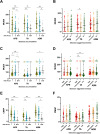Motor unit number index (MUNIX) in the D50 disease progression model reflects disease accumulation independently of disease aggressiveness in ALS
- PMID: 36163485
- PMCID: PMC9512899
- DOI: 10.1038/s41598-022-19911-0
Motor unit number index (MUNIX) in the D50 disease progression model reflects disease accumulation independently of disease aggressiveness in ALS
Abstract
The neurophysiological technique motor unit number index (MUNIX) is increasingly used in clinical trials to measure loss of motor units. However, the heterogeneous disease course in amyotrophic lateral sclerosis (ALS) obfuscates robust correlations between clinical status and electrophysiological assessments. To address this heterogeneity, MUNIX was applied in the D50 disease progression model by analyzing disease aggressiveness (D50) and accumulation (rD50 phase) in ALS separately. 237 ALS patients, 45 controls and 22 ALS-Mimics received MUNIX of abductor pollicis brevis (APB), abductor digiti minimi (ADM) and tibialis anterior (TA) muscles. MUNIX significantly differed between controls and ALS patients and between ALS-Mimics and controls. Within the ALS cohort, significant differences between Phase I and II revealed in MUNIX, compound muscle action potential (CMAP) and motor unit size index (MUSIX) of APB as well as in MUNIX and CMAP of TA. For the ADM, significant differences occurred later in CMAP and MUNIX between Phase II and III/IV. In contrast, there was no significant association between disease aggressiveness and MUNIX. In application of the D50 disease progression model, MUNIX can demonstrate disease accumulation already in early Phase I and evaluate effects of therapeutic interventions in future therapeutic trials independent of individual disease aggressiveness.
© 2022. The Author(s).
Conflict of interest statement
The authors declare no competing interests.
Figures



Similar articles
-
Motor unit number index (MUNIX) loss of 50% occurs in half the time of 50% functional loss according to the D50 disease progression model of ALS.Sci Rep. 2023 Mar 9;13(1):3981. doi: 10.1038/s41598-023-30871-x. Sci Rep. 2023. PMID: 36894607 Free PMC article.
-
[Application value of motor unit number index in patients with amyotrophic lateral sclerosis].Zhonghua Yi Xue Za Zhi. 2019 Nov 19;99(43):3413-3416. doi: 10.3760/cma.j.issn.0376-2491.2019.43.012. Zhonghua Yi Xue Za Zhi. 2019. PMID: 31752469 Chinese.
-
Motor Unit Number Index (MUNIX) detects motor neuron loss in pre-symptomatic muscles in Amyotrophic Lateral Sclerosis.Clin Neurophysiol. 2017 Mar;128(3):495-500. doi: 10.1016/j.clinph.2016.11.026. Epub 2016 Dec 18. Clin Neurophysiol. 2017. PMID: 28043769
-
The evolving role of surface electromyography in amyotrophic lateral sclerosis: A systematic review.Clin Neurophysiol. 2020 Apr;131(4):942-950. doi: 10.1016/j.clinph.2019.12.007. Epub 2019 Dec 27. Clin Neurophysiol. 2020. PMID: 32044239 Free PMC article.
-
Electrodiagnostics: MUNE and MUNIX as methods of estimating the number of motor units - biomarkers in lower motor neurone disease.Neurol Neurochir Pol. 2019;53(4):251-257. doi: 10.5603/PJNNS.a2019.0026. Epub 2019 Jun 17. Neurol Neurochir Pol. 2019. PMID: 31206166 Review.
Cited by
-
Motor unit number index (MUNIX) loss of 50% occurs in half the time of 50% functional loss according to the D50 disease progression model of ALS.Sci Rep. 2023 Mar 9;13(1):3981. doi: 10.1038/s41598-023-30871-x. Sci Rep. 2023. PMID: 36894607 Free PMC article.
-
Biomarkers in amyotrophic lateral sclerosis: current status and future prospects.Nat Rev Neurol. 2023 Dec;19(12):754-768. doi: 10.1038/s41582-023-00891-2. Epub 2023 Nov 10. Nat Rev Neurol. 2023. PMID: 37949994 Review.
-
Prognostic Usefulness of Motor Unit Number Index (MUNIX) in Patients Newly Diagnosed with Amyotrophic Lateral Sclerosis.J Clin Med. 2023 Jul 31;12(15):5036. doi: 10.3390/jcm12155036. J Clin Med. 2023. PMID: 37568439 Free PMC article.
-
Neurophysiological biomarkers of networks impairment in amyotrophic lateral sclerosis.J Neurol. 2025 Jul 14;272(8):507. doi: 10.1007/s00415-025-13229-3. J Neurol. 2025. PMID: 40658257 Review.
References
Publication types
MeSH terms
LinkOut - more resources
Full Text Sources
Medical
Miscellaneous

